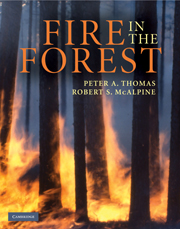Book contents
- Frontmatter
- Contents
- Preface
- List of contributors
- 1 In the beginning
- 2 Historical review
- 3 How a fire burns
- 4 Fire in the wild landscape
- 5 Fire ecology
- 6 The benefits of fire and its use as a landscape tool
- 7 Fire suppression
- 8 Wildland fire and its management – a look towards the future
- Further reading
- References used in the text
- Index
1 - In the beginning
Published online by Cambridge University Press: 05 August 2012
- Frontmatter
- Contents
- Preface
- List of contributors
- 1 In the beginning
- 2 Historical review
- 3 How a fire burns
- 4 Fire in the wild landscape
- 5 Fire ecology
- 6 The benefits of fire and its use as a landscape tool
- 7 Fire suppression
- 8 Wildland fire and its management – a look towards the future
- Further reading
- References used in the text
- Index
Summary
Welcome to Fire in the Forest. The ancient Greeks considered fire as one of the classical elemental forces along with water, earth and air; and indeed fire has helped shape the world around us to such a great extent that it would be hard to argue the point. Without a doubt, there is nothing on this planet that cannot be traced back (many times over) to some kind of fiery origin, whether that be the Big Bang at the origin of the universe, the atomic fires of some long dead pre-supernova star, the liquid burning rock just below the crust of the earth or the vegetation sitting frailly on the surface of the planet. While all of these forging fires are fascinating, a tome that spans the fullness of fire would be many volumes thick. The focus of this book is to explore the various facets of fires in forests: from how a single flame works, to what determines whether a forest will burn, to why huge forest fires occur and how they can be tackled. In this we will be dealing primarily with wildland fires – fires in the natural or semi-natural forest rather than those in plantations or in urban areas. These wildland fires have shaped the planet's biotic structure so we also focus on how plants and animals cope with fire, our own interaction with fire and ultimately our overall relationship with the whole planet.
- Type
- Chapter
- Information
- Fire in the Forest , pp. 1 - 7Publisher: Cambridge University PressPrint publication year: 2010



